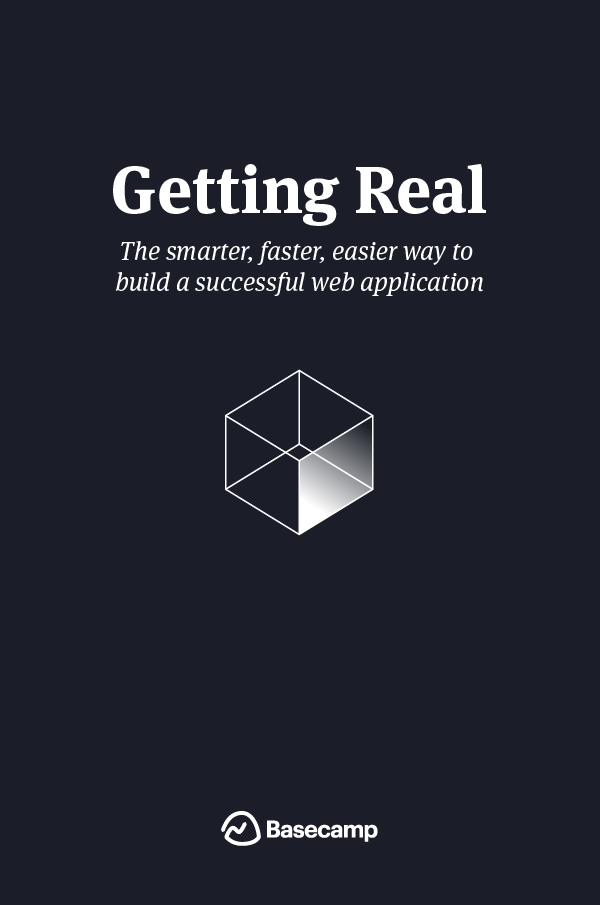In the world of software development, where complexity often reigns supreme, Getting Real by Jason Fried (along with DHH and Matthew Linderman) offers a refreshingly contrarian perspective. Originally published in 20061 by 37signals (now Basecamp), this book distills years of experience into a practical approach to building web applications. While it predates the rise of modern frameworks and tools, its principles remain relevant for entrepreneurs, devs, and PMs who want to cut through the noise.
Unlike many business and technical books, Getting Real isn’t weighed down by jargon. Instead, it delivers quick, actionable insights that challenge conventional wisdom, advocating for simplicity, and a user-first mindset. The book reads like a series of blog posts, making it easy to digest while packing a serious punch in terms of real-world application.
Key Lessons
1. Build for Yourself
One of the most striking ideas in Getting Real is the emphasis on solving your own problems. Fried and his co-authors argue that the best products come from personal necessity rather than market research. If you build something that you yourself need, you’ll have a deeper understanding of what works, what doesn’t, and how to improve it.
2. Embrace Constraints
Instead of seeing limitations—whether they be budget, time, or manpower—as obstacles, Getting Real suggests that they’re actually beneficial. Constraints force teams to be more creative and focus on what truly matters. The book advocates for launching with less features and refining based on real user feedback rather than trying to build the perfect product from D1.
3. Launch Quickly and Iterate
A key philosophy in Getting Real is that software development should be iterative. Rather than waiting months or years to release a fully polished product, teams should aim to launch quickly with a minimum viable product (MVP). This way, they can test real-world usage, make improvements, and adapt based on feedback.
4. Less Software, More Focus
Feature bloat is a common pitfall in software development. Instead of adding everything a user might possibly want, Getting Real encourages focusing only on the essentials. Every feature should justify its existence, and if something isn’t absolutely necessary, it shouldn’t be included. This approach not only makes development faster but also improves usability.
5. Small Teams, Big Impact
Large teams often lead to inefficiencies—more meetings, more approvals, and more bureaucracy. The book argues that small, agile teams are more effective because they can make decisions faster, collaborate more effectively, and maintain a higher level of accountability. The authors practice what they preach, as Basecamp itself has always remained a relatively small team despite its success.
6. Say No More Than Yes
In traditional product development, there’s often pressure to say “yes” to every feature request, client demand, or new trend. Getting Real advises the opposite: say “no” more often than “yes.” By being selective, you maintain control over your product vision and avoid unnecessary complexity.
7. Forget About Formal Business Plans
The book takes a somewhat radical stance against traditional business planning, arguing that lengthy documents and forecasts are often a waste of time. Instead, the authors advocate for quick action—getting something built, launching it, and adjusting as you go based on real-world feedback.
My Thoughts on Getting Real
Reading Getting Real was a breath of fresh air, especially in a world where product development is often overcomplicated. As someone who appreciates lean, effective approaches to building products, I found this book incredibly relevant—even years after its publication.
I particularly resonated with the book’s emphasis on:
- Speed over perfection. There’s often a temptation to polish a product endlessly before launch, but real growth comes from iteration.
- Simplicity over complexity. It’s easy to add more features, but the best products often do a few things exceptionally well.
- Solving personal problems. If you build something for yourself, you naturally understand what’s important.
That said, some of the book’s advice—such as skipping business plans entirely—might not apply universally.
Who Should Read This Book?
- Startup founders looking for a pragmatic approach to product development.
- Software developers who want to build better applications with less complexity.
- PMs aiming to streamline their processes and avoid feature bloat.
- Entrepreneurs who want to launch quickly and iterate based on real user feedback.
Final Verdict
Getting Real is an essential read for anyone involved in building web applications. Its principles—simplicity, iteration, and user-focused development—are timeless. While the examples are rooted in web apps, the lessons apply broadly across startups, product management, and even creative projects.
If you’re looking for a book that cuts through the noise and offers clear, actionable advice, Getting Real is definitely worth your time!
Have you read Getting Real? I’d love to hear your thoughts! Feel free to share your takeaways or how you’ve applied its principles in your own work.


Leave a Reply